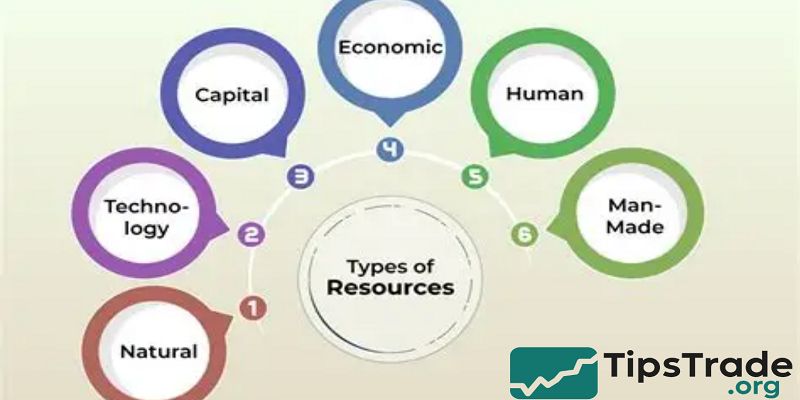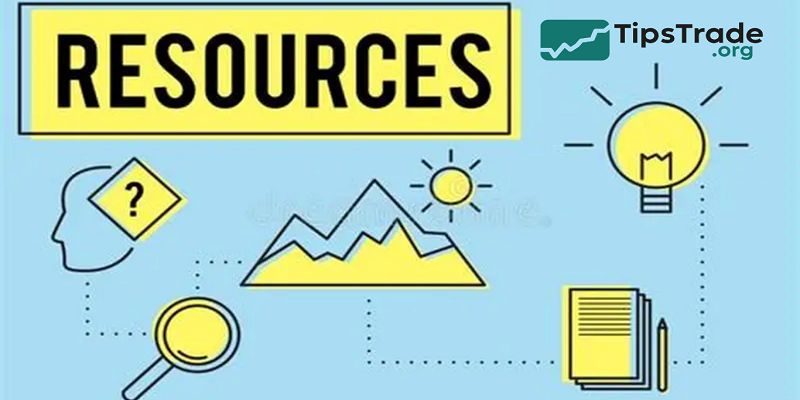Resources are essential elements that individuals, companies, and countries depend on to work, produce value, and survive. In simple terms, resources refer to anything that can be used to create goods, provide services, or support daily life. They include natural elements like water or minerals, human resources such as knowledge and labor, financial assets, physical property, and even modern digital data. This article explains what resources are, the different types, why they matter, and how people and businesses manage them. Visit tipstrade.org and check out the article below for further information.
What is a resource?
The word “resources” refers to assets that provide support, value, or production ability. Economists describe resources as inputs used to produce goods and services.
Without resources, there can be no manufacturing, farming, transportation, or digital innovation. In daily conversation, “resources” also means materials or tools we rely on to accomplish tasks—for example, books for learning, machines for building, or skills used to solve problems.
In business, resources are viewed as strategic assets. A company with strong financial resources can invest in research, marketing, and technology. A company with advanced human resources—like experienced engineers or doctors—can offer skilled services and gain a competitive advantage.
In environmental science, resources mostly refer to natural materials from the earth. The United Nations and the World Bank often publish data showing how natural resources influence a nation’s economic growth and sustainability.
Because resources exist in limited quantities, smart management and long-term planning are required to avoid waste and shortages.
Resources appear in every aspect of life. Some are visible and physical, while others exist in digital or intellectual form. Common examples include:
- Water
- Oil and minerals
- Forests and agriculture
- Money and investment capital
- Skilled workers
- Technology and machines
- Data and software
- Buildings and factories
A modern company might need a combination of all these resources.
For example, a car manufacturer requires natural resources like steel, rubber, and fuel; human resources such as engineers and factory workers; capital resources like machinery; and digital resources like automation software. When any resource becomes limited, production slows and costs increase.
see more:
- Fundamental Analysis and Technical Analysis: Choosing the Right Approach for Investors
- Risks of Fundamental Analysis: A Complete Beginner-Friendly Guide
- Everything to know about fundamental analysis methods in trading
- Free Cash Flow (FCF): Meaning, Formula, and Why It Matters for Investors
Types of Resources

Resources can be classified in many ways, but the most common categories include natural resources, human resources, capital resources, financial resources, and digital or informational resources. Each type plays a different role in society and business.
Natural Resources
Natural resources come directly from the earth. They include renewable and non-renewable materials. Renewable resources, such as sunlight, wind, and forests, can replenish naturally. Non-renewable resources, like oil, coal, and minerals, take millions of years to form and are limited.
According to the United Nations Environment Programme (UNEP), global demand for natural resources has tripled in the past 50 years, mainly due to population growth and industrialization. Countries with rich natural resources—such as Canada, Norway, and Saudi Arabia—often have stronger export power.
However, overuse, pollution, and climate change threaten many natural resources, making sustainable management increasingly important.
Human Resources
Human resources refer to people and their abilities. This includes physical labor, experience, education, creativity, and leadership skills. A business with strong human resources can innovate faster and provide better services.
Research from the OECD shows that countries investing heavily in education and training experience higher productivity and economic growth. In modern industries, knowledge-based human resources—such as IT experts, engineers, designers, and medical professionals—are more valuable than physical labor alone.
Many companies now focus on developing talent, using training programs, employee benefits, and workplace culture to attract skilled workers.
Capital Resources
Capital resources are tools, buildings, equipment, and machinery used for production. A bakery uses ovens. A construction company uses cranes.
A hospital uses medical equipment. Capital resources increase efficiency and allow businesses to produce goods on a larger scale.
Without capital resources, large industries like manufacturing, energy, and transportation would not exist. Investing in advanced technology is one reason why developed countries can create more products with fewer workers.
Digital and Information Resources
In the past, data and software were not considered major resources. Today, digital resources drive nearly every industry. Businesses use data to understand customers, improve services, detect fraud, and forecast trends.
Tech companies such as Google, Amazon, and Microsoft rely heavily on information resources rather than physical materials. Intellectual property, software, patents, and artificial intelligence are now among the most valuable assets in the world.
According to Statista, global data creation will exceed 180 zettabytes by 2025, showing how rapidly digital resources are expanding. Countries and companies with strong technological resources will lead future economic growth.
Financial Resources
Financial resources include money, investment capital, credit, and savings. Without financing, companies cannot pay employees, buy machinery, develop products, or expand operations.
Individuals rely on financial resources for education, housing, healthcare, and business opportunities. When financial resources are limited, even companies with strong ideas and skilled workers struggle to grow.
This is why banks, loans, investors, and capital markets are critical to economic development.
Why Resources Matter

Resources matter because they create value. A country rich in natural resources can produce energy, food, and manufactured goods.
A company with strong financial resources can develop new products. A student with educational resources can learn faster and build a better career. Without resources, progress stops.
Economists explain that when resources are scarce and demand increases, prices rise. For example, if a country has limited water, agriculture becomes more expensive, which increases food prices.
If a company loses skilled workers, productivity decreases. Resources also influence global politics and trade. Oil-rich countries export energy worldwide, while countries with advanced technology export software, pharmaceuticals, or scientific knowledge.
The World Bank reports that resource efficiency—the ability to use resources wisely—is one of the strongest indicators of long-term economic stability.
Resource Management
Resource management refers to planning, allocating, and using assets efficiently. Businesses and governments must manage resources carefully to avoid waste, reduce cost, and ensure sustainability.
Efficient Allocation
Efficient allocation means using resources where they create the most value.
For example, instead of hiring more workers than necessary, a company analyzes productivity data to find the optimal workforce size. Factories use lean manufacturing methods to reduce material waste.
Schools distribute digital resources like laptops to students who need them most. When resources are allocated poorly, money and time are wasted.
Sustainability and Long-Term Use
Sustainability focuses on protecting resources for future generations. Organizations like the United Nations, World Wildlife Fund (WWF), and World Economic Forum report that climate change, deforestation, water scarcity, and pollution threaten long-term access to natural resources.
Companies now invest in renewable energy, recycling, and responsible sourcing to reduce environmental damage. Consumers also support sustainable brands.
For example, many clothing companies switch to recycled fabrics, and energy companies expand solar and wind production. Sustainable resource management ensures that businesses grow without harming the planet.
Tools and Systems for Managing Resources
Many companies use resource-planning tools to track assets, schedule production, and forecast demand. Enterprise Resource Planning (ERP) software helps businesses manage inventory, finances, workers, and equipment.
Project management tools help teams assign tasks and track deadlines. In supply chain industries, AI predicts demand to prevent shortages.
Good resource management reduces costs and improves efficiency, which is why nearly every large company uses digital systems to control operations.
Challenges Related to Resources

Even though resources bring value, they also create challenges. Some are limited, expensive, or difficult to access. Others are affected by politics, weather, war, or market conditions.
Common challenges include:
- Shortage and scarcity
- Rising costs
- Environmental impact
- Unequal distribution
- Over-consumption
- Pollution and climate change
A real example is the global semiconductor shortage in 2020–2022. Digital resources and manufacturing materials became limited, causing delays in smartphones, computers, and cars. Another example is water scarcity in many regions.
The United Nations estimates that more than 2 billion people live in countries with high water stress. When resources are limited, countries compete harder, and prices rise, affecting businesses and families.
Real-World Examples of Resources in Business

Businesses rely on resources to operate, compete, and innovate. A coffee company like Starbucks uses natural resources (coffee beans, water), human resources (baristas, managers), capital resources (shops, machines), and financial resources (investment and revenue).
Toyota uses natural resources for materials, capital resources for robotic factories, skilled human workers, and advanced digital data systems for supply chain control. These real examples show that success comes not from one resource, but from combining many.
Companies also try to protect resources. For instance, many technology brands recycle old devices to recover valuable metals.
Food companies invest in sustainable farming to protect soil and water. Proper resource management improves reputation, lowers cost, and supports long-term growth.
Conclusion
Resources are the foundation of all human activity. They power economies, support industries, feed populations, and drive innovation. Natural, human, financial, and digital resources each provide unique value, and societies that manage them wisely enjoy stronger development. However, because many resources are limited, it is important to use them responsibly through sustainability, planning, and technology. Whether on a national, business, or personal level, those who understand resources can make better decisions in the future.
see more

